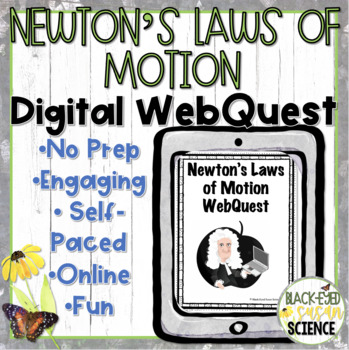Newton's Laws of Motion DIGITAL WebQuest (NGSS aligned)
- PDF
- Google Apps™
- Internet Activities
- Webquests

What educators are saying
Also included in
- This is a custom bundle but you may purchase this custom bundle for yourself or request your own by emailing blackeyedsusanscience@gmail.com.Get exactly what you want and save money doing it!How to order your customized bundle: (It’s EASY)Step #1: Choose at least 10 items.Step #2: Email the list toPrice $169.90Original Price $244.00Save $74.10
- ***SAVE 20%***With your purchase of this Growing Digital Resources Bundle, you will receive all new digital resources free of charge. If you purchase this bundle now - you will receive all of the next sets for free! As each new resource is added, the price will go up.Resources are aligned with NexPrice $120.80Original Price $151.00Save $30.20
- This engaging WebQuest can be completed individually, with partners, or in groups. The purpose of this WebQuest is for students to learn about Newton's Three Laws of Motion.Some topics in this WebQuest:*force*motion*Newton's First Law of Motion*Newton's Second Law of Motion*Newton's Third Law of MotPrice $8.00Original Price $10.00Save $2.00
Description
This engaging WebQuest can be completed individually, with partners, or in groups. The purpose of this WebQuest is for students to learn about Newton's Three Laws of Motion.
Some topics in this WebQuest:
*force
*motion
*Newton's First Law of Motion
*Newton's Second Law of Motion
*Newton's Third Law of Motion
*F=ma
This activity guides students through exploring information and videos through the use of embedded links. Students are led through components of a WebQuest: introduction, task, process, final task, and conclusion. As a final task, students are asked to watch a video and identify each law of motion.
Assign through Google Classroom.
A comprehensive answer key included.
Next Generation Science Standards covered:
MS-PS2-1
Apply Newton’s Third Law to design a solution to a problem involving the motion of two colliding objects. Examples of practical problems could include the impact of collisions between two cars, between a car and stationary objects, and between a meteor and a space vehicle. Assessment is limited to vertical or horizontal interactions in one dimension.
MS-PS2-2
Plan an investigation to provide evidence that the change in an object’s motion depends on the sum of the forces on the object and the mass of the object. Emphasis is on balanced (Newton’s First Law) and unbalanced forces in a system, qualitative comparisons of forces, mass and changes in motion (Newton’s Second Law), frame of reference, and specification of units. Assessment is limited to forces and changes in motion in one-dimension in an inertial reference frame, and to change in one variable at a time. Assessment does not include the use of trigonometry.
MS-PS2-3
Ask questions about data to determine the factors that affect the strength of electric and magnetic forces. Examples of devices that use electric and magnetic forces could include electromagnets, electric motors, or generators. Examples of data could include the effect of the number of turns of wire on the strength of an electromagnet, or the effect of increasing the number or strength of magnets on the speed of an electric motor. Assessment about questions that require quantitative answers is limited to proportional reasoning and algebraic thinking.
Customer Tips:
Get TPT credit to use on future purchases:
- Please go to your My Purchases page (be sure you are logged in). At the top of the page you'll see a box and the message “Give feedback on recent purchases”. Simply click the “GIVE FEEDBACK” button and you will be taken to a page where you can give a quick rating and leave a comment for the product. I highly value your feedback. It helps me to make resources that meet your needs.
- Also, be the first to know about new resources, freebies, and sales - just click the green star at the top of the page next to the Black-Eyed Susan Science logo. You will then receive customized email updates about my new products.
Thank you for visiting Black-Eyed Susan Science!








